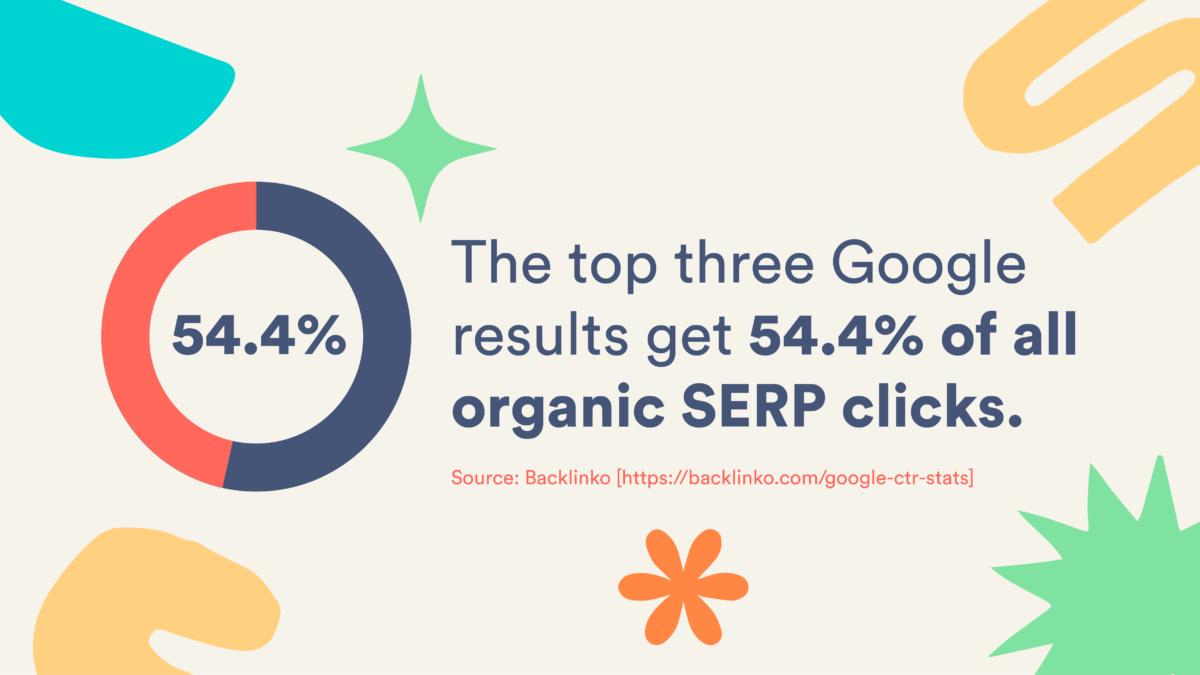54.4% of all organic SERP clicks on Google are claimed by the top three results, according to Backlinko.
What’s more, your position on the SERPs can significantly impact your click-through rate. For example, going from second to first spot on the first page of Google SERPs may get you 74.5% more clicks.

Getting top results is particularly important in fintech, an industry that is growing rapidly and attracting a lot of competition. Effective SEO strategies can be game-changers, helping you stand out and connect with the right audience. However, before diving into the strategies, it’s important to understand what makes SEO for fintech different.
Understanding SEO for fintech
While the core principles of SEO remain consistent across industries, several key aspects make SEO for fintech companies distinct from SEO for businesses in other sectors. These distinctions stem from the unique nature of the fintech industry, which is characterized by:
- High regulation: Fintech companies operate in a heavily regulated environment governed by strict compliance requirements. This necessitates a deep understanding of the regulatory landscape to adhere to a spectrum of regulations, encompassing advertising, marketing, and data privacy. When you align with the stringent requirements in the fintech space, you can avoid penalties and establish trust within the ecosystem.
- Technical complexity: Fintech products and services often involve specialized jargon, technological concepts, and terminology that may need clarification for the layperson. As such, SEO for fintech companies requires expertise in explaining these technical concepts in a way that is accessible to a non-technical audience while still maintaining accuracy and relevance. You must also be able to translate complex financial concepts into clear, concise content that adheres to regulatory guidelines.
- Content relevance and accuracy: Content in the fintech space must be accurate, up-to-date, and relevant to the needs of the target audience. This requires staying abreast of industry trends, regulatory changes, and consumer behavior to ensure that content remains informative and valuable.
- Security and privacy concerns: Fintech companies handle sensitive financial data, making security and privacy paramount. SEO efforts must align with strict data protection protocols and emphasize the company’s commitment to safeguarding user information.
- The need for high levels of trust: Financial matters are deeply personal and sensitive, making trust a crucial factor for fintech companies. SEO strategies for fintech must emphasize building credibility, establishing expertise, and fostering trust among potential customers.
- Fierce competition: The fintech industry is highly competitive, with numerous companies vying for the attention of the same target audience. This means that SEO for fintech companies requires a focus on content differentiation and strategic authority building to stand out from the crowd.
- Continuous adaptation and innovation: The world of fintech is constantly evolving, and SEO strategies must adapt to keep pace with new technologies, market trends, and regulatory developments.
Therefore, tailoring SEO efforts to address these challenges is essential for success. Here are nine strategies that you can use to improve SEO for your fintech company.
1. Know Your Audience
The first step in any effective SEO strategy is understanding your audience. For fintech companies, this means going beyond demographics and understanding the pain points of your target audience. Develop a strategy that focuses on helping rather than selling. Connect with your audience on a human level by addressing their financial concerns and providing valuable solutions.
Take SoFi, for example. This leading online personal finance company offers a wide range of financial products, including student loan refinancing, personal loans, credit cards, and investing. The brand stands out because of its customer-centric approach and focus on providing easy-to-understand financial education and resources to help customers make informed decisions about their finances.
Rather than aggressively pushing sales, SoFi has gained a loyal customer base by demonstrating a genuine commitment to helping customers achieve their financial goals.

2. Go beyond keywords
While keywords are essential, a successful fintech SEO strategy requires going beyond basic keyword optimization. To truly optimize for search engines and, more importantly, user satisfaction, you need to adopt a more holistic approach to SEO, one that emphasizes understanding their audience, addressing complex queries, and building trust.
Deep dive into your fintech expertise
Before embarking on SEO endeavors, ensure an intimate understanding of your fintech products and services. This not only aids in crafting more informed content but also enhances the ability to communicate complex financial concepts effectively.
Understanding user intent is also paramount. Tailor your content to address your audience’s specific needs and inquiries, aligning seamlessly with their search intent.
Answer the complex queries
While keywords remain integral, prioritize addressing complex queries that reflect the intricate nature of fintech. Craft content that not only incorporates relevant keywords but goes further to provide comprehensive answers to the tough questions your audience may pose. Your SEO strategy should bridge the gap, explaining these complexities in a manner accessible to a non-technical audience while maintaining accuracy.
Strategic communication for user satisfaction
Translate complex financial concepts into straightforward, concise content. This not only aids in user comprehension but also aligns with regulatory guidelines, ensuring your content remains informative and compliant.
In addition, trust is foundational. Use your content to provide information, build credibility, and demonstrate transparency. Communicate your expertise and commitment to addressing user needs and protecting their data and privacy. For example, this can be achieved by clearly communicating pricing structures, fees and terms, and data security and privacy compliance.
Embrace rich content formats
Beyond text-based content, your fintech companies can leverage rich content formats to enhance your SEO efforts. Videos, infographics, and interactive tools can provide a more engaging and informative experience for users, increasing dwell time and signaling to search engines that the content is valuable.
Optimize for voice search
Per Google findings, 27% of the online global population uses voice search on mobile.

Voice search is rapidly gaining traction, so you must optimize your website’s content for natural language queries, using conversational language and incorporating long-tail keywords.
Embrace thought leadership
Establish your company as a thought leader in the fintech industry by actively participating in industry events, contributing to relevant publications, and sharing your expertise through blog posts, webinars, and social media.
By going beyond using keywords in your content, your SEO strategy becomes a powerful tool not just for search engine visibility but for building meaningful connections with your audience. Optimize for keywords, but also embrace the complexity and position your fintech company as a trusted source in the digital landscape.
3. Prioritize mobile optimization to capture your fintech audience on the go
Mobile optimization is no longer optional; it’s a necessity. With most internet traffic now coming from mobile devices — 57.8% to be precise — your fintech company must ensure a seamless and responsive mobile experience. Moreover, Google has transitioned to mobile-first indexing, which means the giant search engine prioritizes mobile-friendly websites in its rankings, making mobile optimization a critical aspect of your SEO strategy.
When going mobile, keep the following best practices in mind:
- Use a responsive design that adapts to different screen sizes, ensuring fast loading times and a seamless user experience on mobile devices.
- If your company offers a mobile app, optimize it for discoverability and downloads. This includes using relevant keywords in app titles and descriptions, providing high-quality screenshots and app previews, and encouraging user reviews.
- As mobile users increasingly rely on their smartphones for local searches, optimizing your website and app for local SEO is essential. For example, this can include registering your business with Google My Business, ensuring consistent NAP (Name, Address, Phone Number) information across all platforms, and encouraging local reviews.
- The content on your mobile website and app should be tailored for mobile users. This involves using shorter paragraphs, larger fonts, easy-to-navigate menus, and high-quality images that are optimized for mobile screens.
- Make it easy for mobile users to take the desired action, whether it’s signing up for an account, downloading an app, or making a transaction. Use clear and visible calls to action, optimized for mobile screens and touch interactions.
- Provide easy access to customer support for mobile users. Offer mobile-optimized live chat, email support, or in-app help options.
As one MarTech headline put it, “To mobile consumers, impatience is a virtue.” Since mobile users are known for being notoriously impatient, your website and app need to load quickly. Optimize your images, minimize code, and leverage caching mechanisms to ensure a speedy mobile experience.

- Monitor your website and app analytics to gain insights into mobile user behavior. Understand how users interact with your content, identify areas for improvement, and make data-driven decisions to enhance your mobile SEO strategy.
- Regularly test your website and app on various mobile devices to identify usability issues or compatibility problems. Ensure that your content is easy to read, forms are easy to fill, and navigation is intuitive across different screen sizes and operating systems.
- Tailor your marketing campaigns to reach mobile users. Use mobile-specific ad formats, target mobile audiences on social media, and optimize your email campaigns for mobile devices.
In addition to enabling you to generate more traffic from mobile search, optimizing for mobile will improve the overall user experience for your visitors, helping to increase engagement and user satisfaction.
4. Build backlinks
Building backlinks is a proven method for boosting SEO, but for fintech companies, acquiring them requires a strategic approach. For example, the fierce competition in the fintech space means customer acquisition is difficult, so backlinks are expensive.
According to Social Media Magazine, “The lifetime link value in FinTech is usually more than $15,000, which is the highest on the internet at a vertical level.” This means that using financial bloggers, often seen as a great potential source for links, can be pricy. Then, there’s also the issue of verifying reputation and authenticity due to the sensitivity of the fintech sector, which makes the entire process of acquiring backlinks much more difficult.
An excellent way to circumvent the difficulties is to consider building links from alternate but relevant niches to diversify your backlink profile. For instance, you can try to acquire backlinks through special interest groups (wellness and financial literacy, for example) and news sites. You can also use top-funnel rankings for passive link generation.
Other ways to build backlinks include:
- Contributing high-quality guest posts and articles to reputable publications with audiences interested in financial products. Additionally, explore content syndication opportunities to distribute your content across a wider network of websites, gaining valuable backlinks and expanding your reach.
- Connecting with journalists and bloggers who cover the fintech industry. Pitch newsworthy stories, provide expert commentary, and offer valuable insights for their articles. This can lead to backlinks from their publications and establish your company as a trusted source of information.
- Actively engaging in industry forums, online communities, and social media groups related to fintech. Share your insights, answer questions, and provide valuable contributions to establish your expertise and credibility. This can lead to organic backlinks from other participants who value your insights.
- Creating visual content, such as infographics, charts, and videos. Such content is highly shareable and can attract backlinks from other websites interested in embedding your content.
- Showcasing your company’s success stories and positive customer experiences through case studies and testimonials. Sharing these compelling narratives and encouraging your customers to share them on their own platforms can generate backlinks from industry publications interested in featuring your company’s achievements.
- Submitting your website to relevant business directories and listings within the fintech industry. This can increase your online visibility and potentially lead to backlinks from these directories.
- Building relationships with fintech influencers and thought leaders. Engaging with their content, participating in their discussions, and offering valuable insights can lead to backlinks from their websites or mentions in their social media posts.
- Actively promoting your content on social media platforms to increase its visibility and encourage social sharing. This can lead to backlinks from other websites that find your content valuable and relevant.
Building backlinks is a strategic and ongoing process, requiring patience, persistence, and a commitment to creating high-quality content that resonates with your target audience. By following these tips, your fintech company can build a strong backlink profile, enhance SEO performance, and establish authority in the competitive fintech landscape.
5. Prioritize UX
User experience (UX) is a critical factor in SEO success. Your fintech website should prioritize a user-friendly interface, easy navigation, and clear calls to action. A positive UX not only enhances your search rankings but also contributes to increased user engagement and satisfaction.

6. Run ads to build momentum
Given the competitive nature of fintech, achieving great results in the traditional organic SEO sense is difficult, to say the least. Running targeted ads can complement your organic SEO efforts and build momentum for your fintech brand. Use paid advertising strategically to reach a broader audience and create brand awareness. Incorporate relevant keywords into your ad copy to align your paid and organic strategies.
7. Don’t sleep on video content
Consider this: on average, a person watches 17 hours of online video per week, according to Wyzowl. Plus, people are 52% more likely to share video content than other types of content like product pages, blogs, and social posts.
Video content has become increasingly popular across all industries, including fintech. Leverage the power of video to explain complex financial concepts, showcase product features, and connect with your audience on a personal level. Videos can also enhance your website’s dwell time, positively impacting SEO.
If you’re ever in doubt of the power of video content, just remember that 96% of marketers say it’s important to their strategy. That’s a number you can’t ignore.
8. E-E-A-T is more important than ever
E-E-A-T, also known as double E-A-T, stands for Experience, Expertise, Authoritativeness, and Trustworthiness. While these critical components of Google’s search quality guidelines are not a ranking factor on Google’s algorithm, they can improve your SEO in several ways:
- Google’s search algorithms prioritize websites that demonstrate a high level of E-E-A-T, meaning they are considered to be authoritative, trustworthy, and reliable sources of information. By adhering to these guidelines, you can improve the chances of your website ranking higher in search results for relevant keywords, increasing visibility and organic traffic.
- E-E-A-T guidelines align with providing a positive user experience and building trust with visitors. Websites that follow these guidelines tend to offer high-quality, accurate, and relevant content, which enhances user satisfaction and encourages repeat visits. Additionally, demonstrating E-E-A-T signals to users that the website is a credible source of information, fostering trust and confidence.
- E-E-A-T guidelines are core to a company’s overall search quality guidelines. By following these guidelines, you can ensure your website is compliant with Google’s standards and avoid potential penalties or negative rankings due to non-compliance.
- Adhering to E-E-A-T guidelines is not just about short-term ranking gains; it’s an investment in long-term SEO success. If your website consistently demonstrates E-E-A-T principles, it’s more likely to maintain high rankings and attract organic traffic over time as Google’s algorithms continue to prioritize these factors.

By consistently providing high-quality, authoritative, and trustworthy content, you can align your website with Google’s expectations and reap the benefits of a solid online presence.
9. Don’t skimp on technical SEO
Financial websites often fall on the smaller side in terms of size, typically under 10,000 pages. This means that technical SEO issues are less common compared to massive platforms like Amazon, which currently has over 200,000,000 indexed pages.
However, technical SEO is still essential; you shouldn’t overlook it. To stay on top of your technical SEO:
- Ensure website crawlability: Make sure your website is crawlable by ensuring all pages are easily accessible through internal linking and a clear sitemap. Use robots.txt to guide crawlers to the most important pages and prevent them from accessing unnecessary areas.
- Optimize page loading speed: Optimize your website’s performance by minimizing image sizes, compressing code, and leveraging caching mechanisms. Use tools like Google PageSpeed Insights to identify and address performance bottlenecks.
- Implement structured data markup: Structured data markup provides search engines with additional context about your website’s content, enhancing its visibility and ranking potential. Implement structured data for your fintech products, services, and company information to improve search results and enable rich snippets.
- Embrace mobile-first indexing: Ensure your website is optimized for mobile devices by using a responsive design, providing fast loading times, and creating a seamless user experience across all screen sizes.
- Address security vulnerabilities: Implement SSL/TLS encryption to protect user data and ensure your website is free from malware or security vulnerabilities. Google may penalize websites that pose security risks.
- Handle URL structure and canonicalization: Use clear and concise URLs that accurately reflect the content of each page. Avoid duplicate content by implementing canonicalization to indicate the preferred version of a page.
- Monitor website health and technical issues: Regularly monitor your website’s health using tools like Google Search Console to identify technical issues, crawl errors, and potential penalties. Address these issues promptly to maintain optimal website performance.
- Seek professional technical SEO assistance: Technical SEO can be complex and time-consuming. Consider seeking assistance from experienced technical SEO professionals to ensure your website’s technical foundation is optimized for search engines.
Technical SEO is not just about ticking off a checklist; it’s about creating a robust foundation for your fintech website that supports your overall SEO strategy and enhances your website’s visibility and user experience. Investing in technical SEO lays the groundwork for long-term SEO success, attracting organic traffic, boosting conversions, and achieving your business goals.
Mastering the fintech SEO landscape
Mastering SEO is a fundamental aspect of achieving success in the competitive landscape of the fintech industry. The nine actionable strategies outlined in this guide will help you enhance your online visibility, connect with your target audience, build trust, and ultimately drive business success.
As you refine your SEO strategy, remember that SEO for fintech is not just about rankings; it’s about aligning your efforts with overarching marketing goals. Fintech marketing is a multifaceted journey that requires a deep understanding of the industry, audience, and evolving trends. For further insights into creating a comprehensive fintech marketing strategy, check out How to create a fintech marketing strategy that works.










